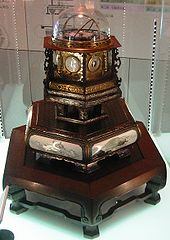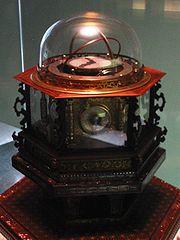
Myriad year clock
Encyclopedia


Hisashige Tanaka
was a Japanese engineer and inventor during the late Edo and Meiji period Japan. He is one of the founders of what later became Toshiba Corporation. He has been called the "Thomas Edison of Japan" or Karakuri Giemon....
in 1851. It belongs to the category of Japanese clocks called Wadokei. This clock is designated as an Important Cultural Asset by Japanese government.
The clock is driven by a spring
Spring (device)
A spring is an elastic object used to store mechanical energy. Springs are usually made out of spring steel. Small springs can be wound from pre-hardened stock, while larger ones are made from annealed steel and hardened after fabrication...
. Once it is fully wound, it can work for one year without another winding. It can show the time in 7 ways (such as usual time, the day of the week, month, moon phase, Japanese time, Solar term
Solar term
A solar term is any of 24 points in traditional East Asian lunisolar calendars that matches a particular astronomical event or signifies some natural phenomenon. The points are spaced 15° apart along the ecliptic and are used by lunisolar calendars to stay synchronized with the seasons. Solar terms...
.) It also rings chimes every hour. It consists of more than 1,000 parts to realize these complex functions, and it is said that Tanaka made all the parts by himself with simple tools such as files and saws. It took more than 3 years for him to finish the assembly.
In 2004, a project funded by the Japanese government tried to make the copy of this clock. More than 100 engineers joined the project and it took more than 6 months with the latest industrial technologies. However, even then it was not possible to make exact copies of some parts, such as the brass metal plate used as its spring, before the presentation at Expo 2005
Expo 2005
Expo 2005 was the World's Fair held for 185 days between Friday, March 25 and Sunday, September 25, 2005, in Aichi Prefecture, Japan, east of the city of Nagoya. It was a Specialized International Exhibition under the scheme of the 1972 protocol of the Convention relating to International Exhibitions...
.
The original of the clock is displayed at Tokyo National Science Museum, while the copy is at Toshiba Corporation.
The clock, technologically comparable to contemporary Western clocks, was developed through a combination of Japanese knowhow and study of Western sciences ("Rangaku
Rangaku
Rangaku is a body of knowledge developed by Japan through its contacts with the Dutch enclave of Dejima, which allowed Japan to keep abreast of Western technology and medicine in the period when the country was closed to foreigners, 1641–1853, because of the Tokugawa shogunate’s policy of national...
"), during Japan's seclusion period
Sakoku
was the foreign relations policy of Japan under which no foreigner could enter nor could any Japanese leave the country on penalty of death. The policy was enacted by the Tokugawa shogunate under Tokugawa Iemitsu through a number of edicts and policies from 1633–39 and remained in effect until...
.
The clock is listed in Mechanical Engineering Heritage
Mechanical Engineering Heritage (Japan)
The is a list of sites, landmarks, machines, and documents that made significant contributions to the development of mechanical engineering in Japan. Items in the list are certified by the .- Overview :...
item No.22 in 2007.

